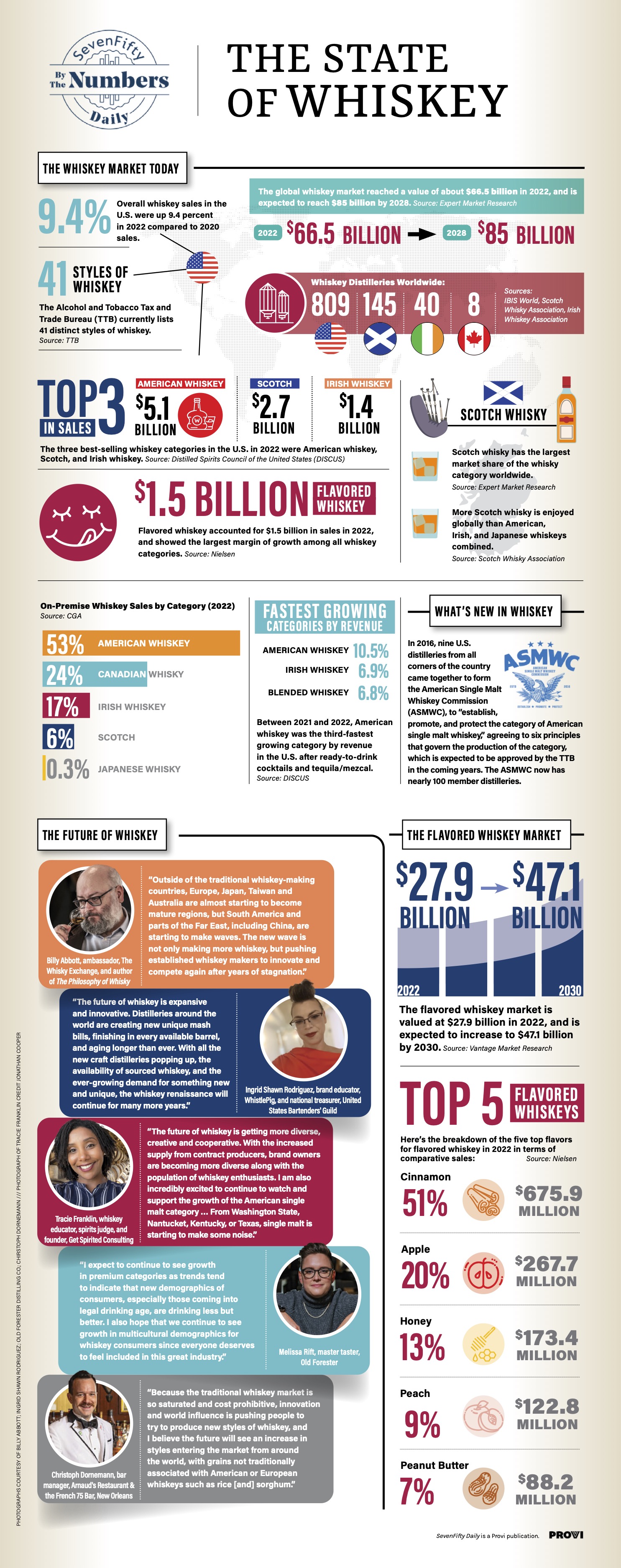The State of the Whiskey Market
American whiskey is the major driver of category growth in the U.S., but Scotch is still king in terms of market share. Find out where the whiskey market stands today with our data-based infographic

Estimated to be a $66.5 billion industry in 2022, whiskey of all kinds has demonstrated massive growth, with several major whiskey categories doubling their outputs over the past 10 years. While vodka remains America’s most popular spirit overall, whiskey has become the best-selling spirit category for on-premise consumption in recent years, with American whiskey, Canadian whisky, and Irish whiskey accounting for 94 percent of on-premise whiskey sales. Scotch, however, is the biggest seller worldwide, with total sales amounting to more than American, Irish, and Japanese whiskeys combined.
While these traditional whiskey styles top the current market in the U.S., “innovation and influence are pushing people to try to produce new styles of whiskey,” says Christoph Dornemann, the bar manager at Arnaud’s Restaurant and the French 75 Bar in New Orleans. “I believe the future will see an increase in styles entering the market from around the world with grains not traditionally associated with American or European whiskeys such as rice [and] sorghum,” beyond the typical whiskey grains such as barley, corn, wheat, and rye.
India, Japan, and Australia have already become major players in the whiskey game, with Indian whisky accounting for seven out of 10 of the best-selling brands worldwide, and Japanese whisky claiming a 0.3 percent share of on-premise sales in the U.S. While only representing a fraction of the market share, this nonetheless translates to significant sales dollars and demonstrable growth for a category that was largely unknown to American drinkers a decade ago. Other countries such as Scandinavia or regions in the Asia Pacific sector are expected to become heavy hitters in the years to come. Flavored whiskeys, premium bottlings, and a wider variety of barrel conditioning finishes are also expected to increase with the demand for new and innovative products.
With 39 percent of whiskey drinkers between the ages of 21 and 35, and only 17 percent over the age of 55, brands are pushing boundaries, not only with the product itself, but also with packaging in order to be more inclusive and appeal to younger, more diverse audiences. “I hope that we continue to see growth in multicultural demographics for whiskey consumers since everyone deserves to feel included in this great industry,” says Melissa Rift, the master taster for Old Forester.
With the whiskey industry projected to reach $85 billion in sales in the next five years, see our infographic below for a comprehensive look at the state of whiskey right now.


Your point of view caught my eye and was very interesting. Thanks. I have a question for you.
Your article helped me a lot, is there any more related content? Thanks!
Thanks for sharing. I read many of your blog posts, cool, your blog is very good.
Thank you for your sharing. I am worried that I lack creative ideas. It is your article that makes me full of hope. Thank you. But, I have a question, can you help me?
Your article helped me a lot, is there any more related content? Thanks!
Thank you for your sharing. I am worried that I lack creative ideas. It is your article that makes me full of hope. Thank you. But, I have a question, can you help me?
I have read your article carefully and I agree with you very much. This has provided a great help for my thesis writing, and I will seriously improve it. However, I don’t know much about a certain place. Can you help me?
Thank you for your sharing. I am worried that I lack creative ideas. It is your article that makes me full of hope. Thank you. But, I have a question, can you help me?
Thanks for sharing. I read many of your blog posts, cool, your blog is very good.
Thanks for sharing. I read many of your blog posts, cool, your blog is very good.
Very interesting details you have mentioned, appreciate it for posting.Blog monetyze
I don’t think the title of your article matches the content lol. Just kidding, mainly because I had some doubts after reading the article.